Study on the Development of an Optimal Heat Supply Control Algorithm for Group Energy Apartment Buildings According to the Variation of Outdoor Air Temperature
Abstract
:1. Introduction
2. Analysis of Group Energy Apartment Building Heat Loss
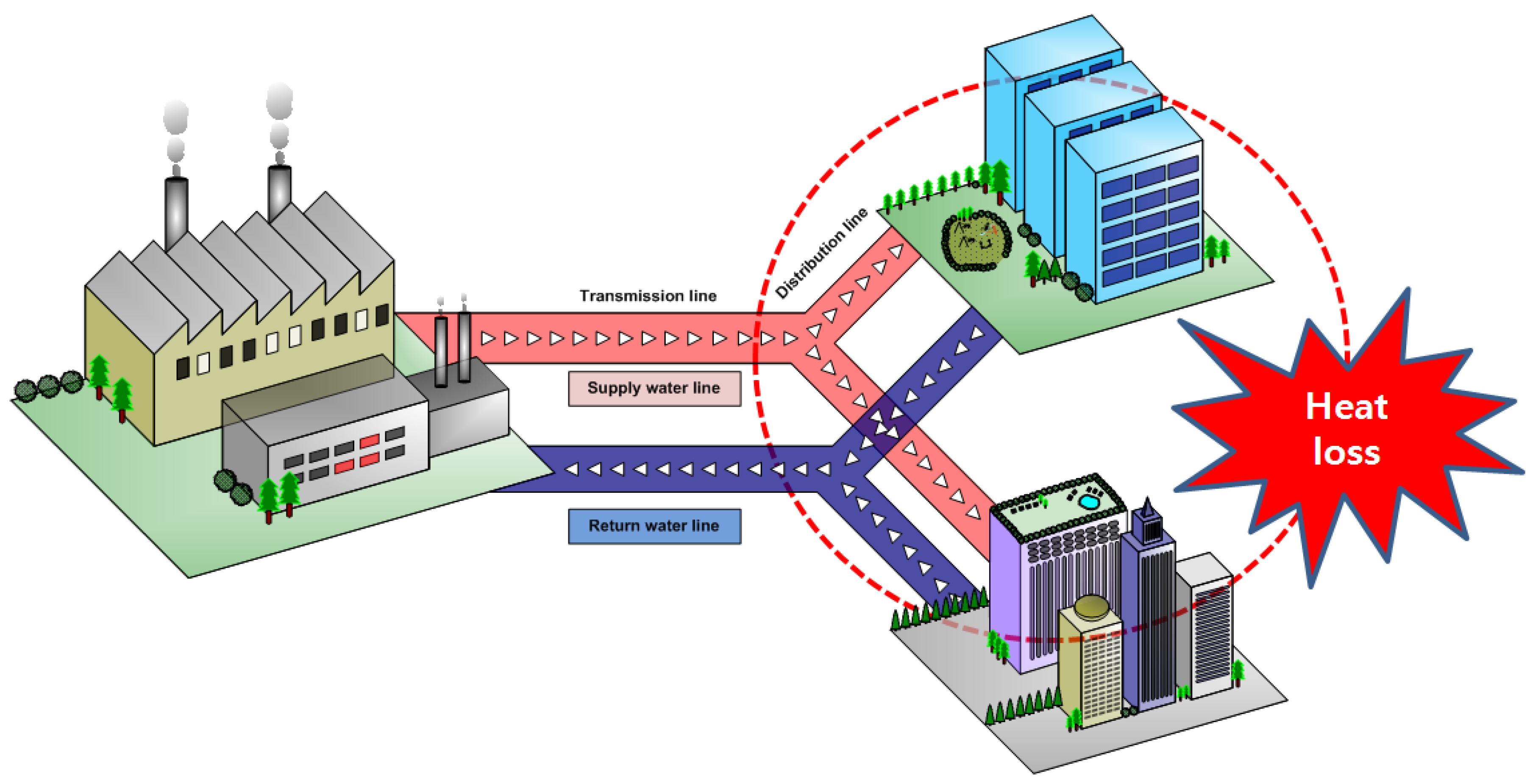
| Item | Specifications |
|---|---|
| Object building | Apartment building |
| Number of households | 1473 |
| Period | 2008.01.01~2008.12.31 |
| Location | Hwaseong city, Gyeonggi-do, Korea |
| Heating source | District heating |
Experimental Data for Numerical Analysis
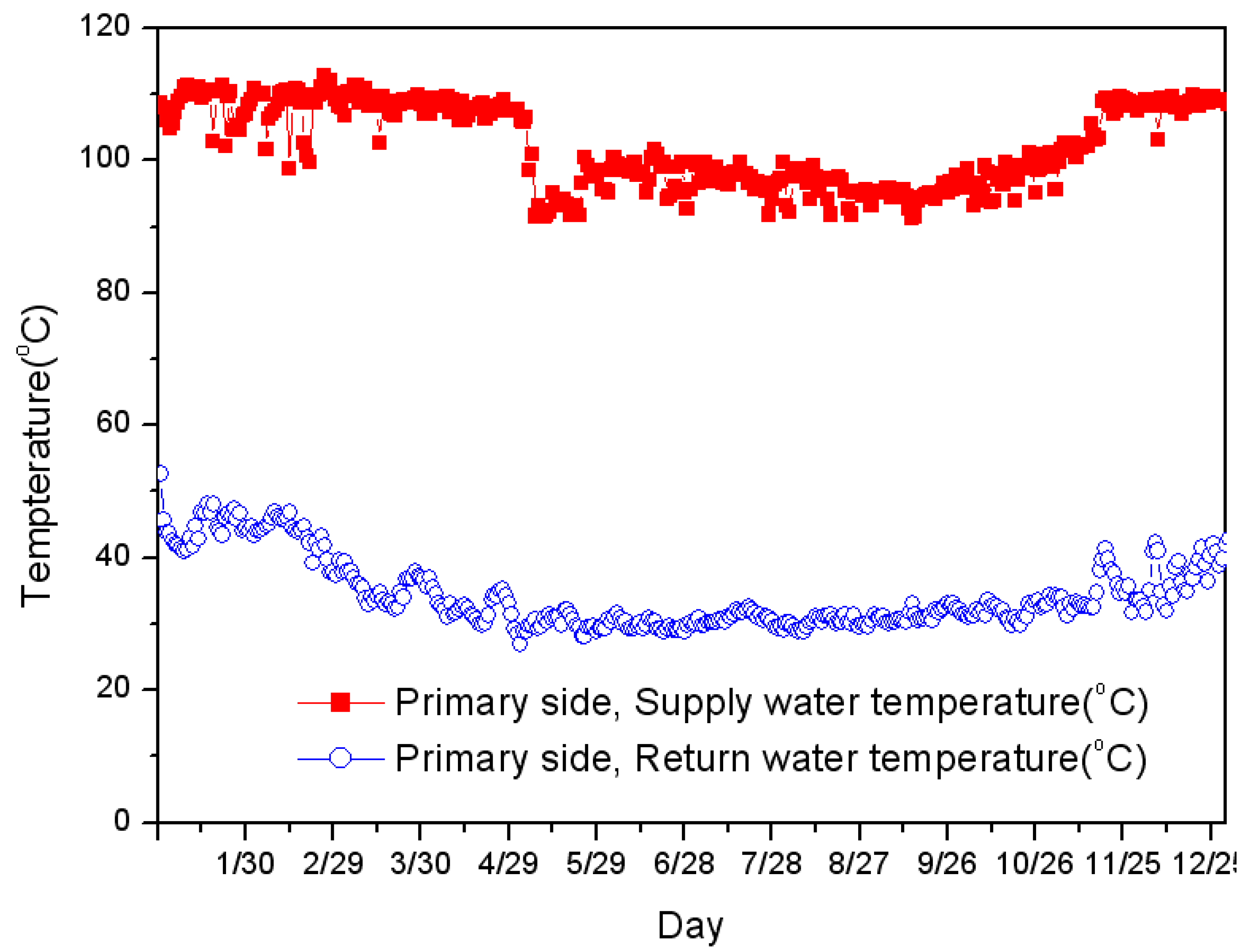

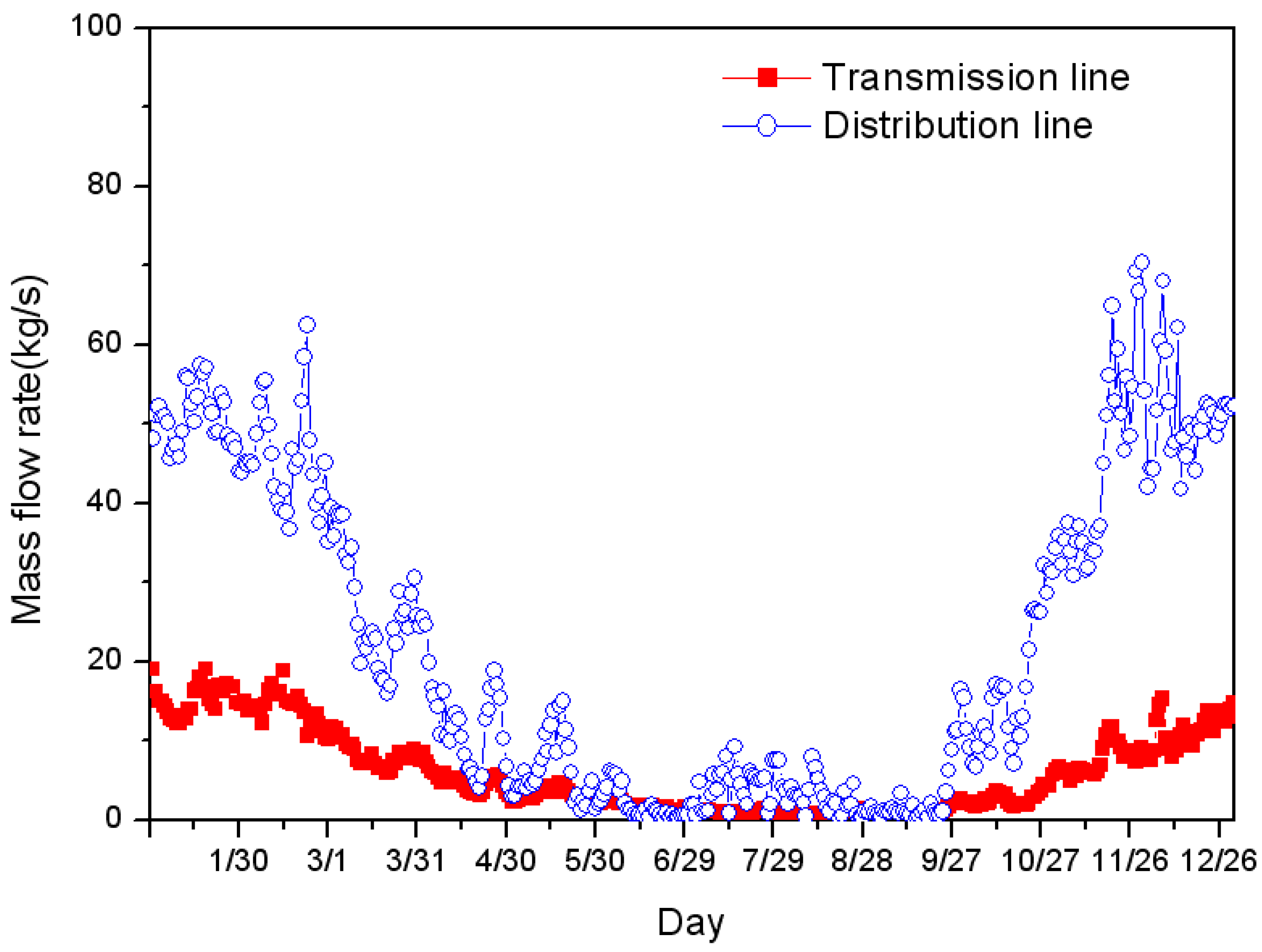



- Constraint: Supply heat needed in individual homes according to outdoor temperature variation.
- Objective function: Determine supply water temperature and return water temperature that yield the lowest heat loss rate on the consumer side distribution line.
3. Analysis of Heat Loss in Heat Distribution Line of Target Group Energy Apartment Building
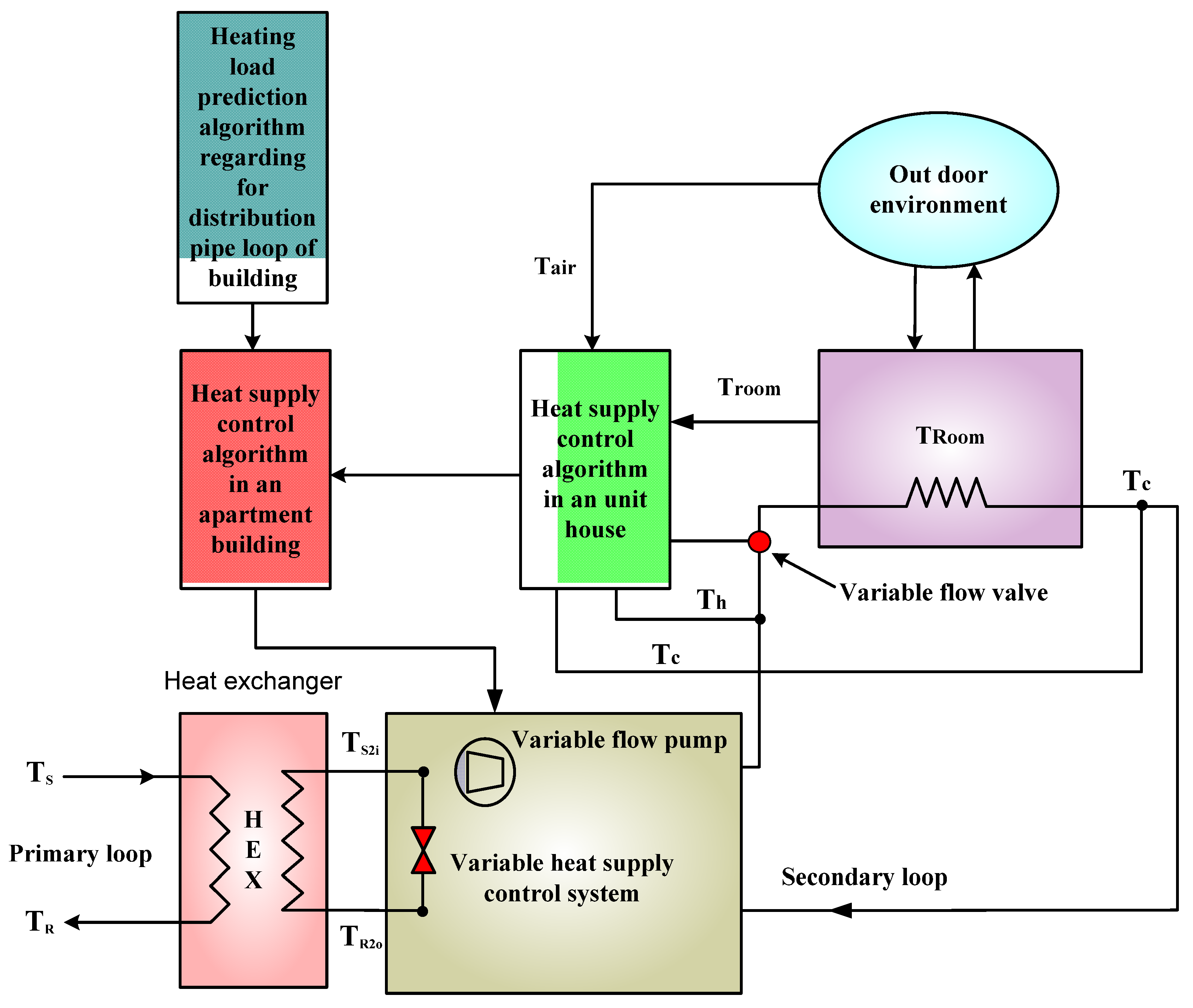
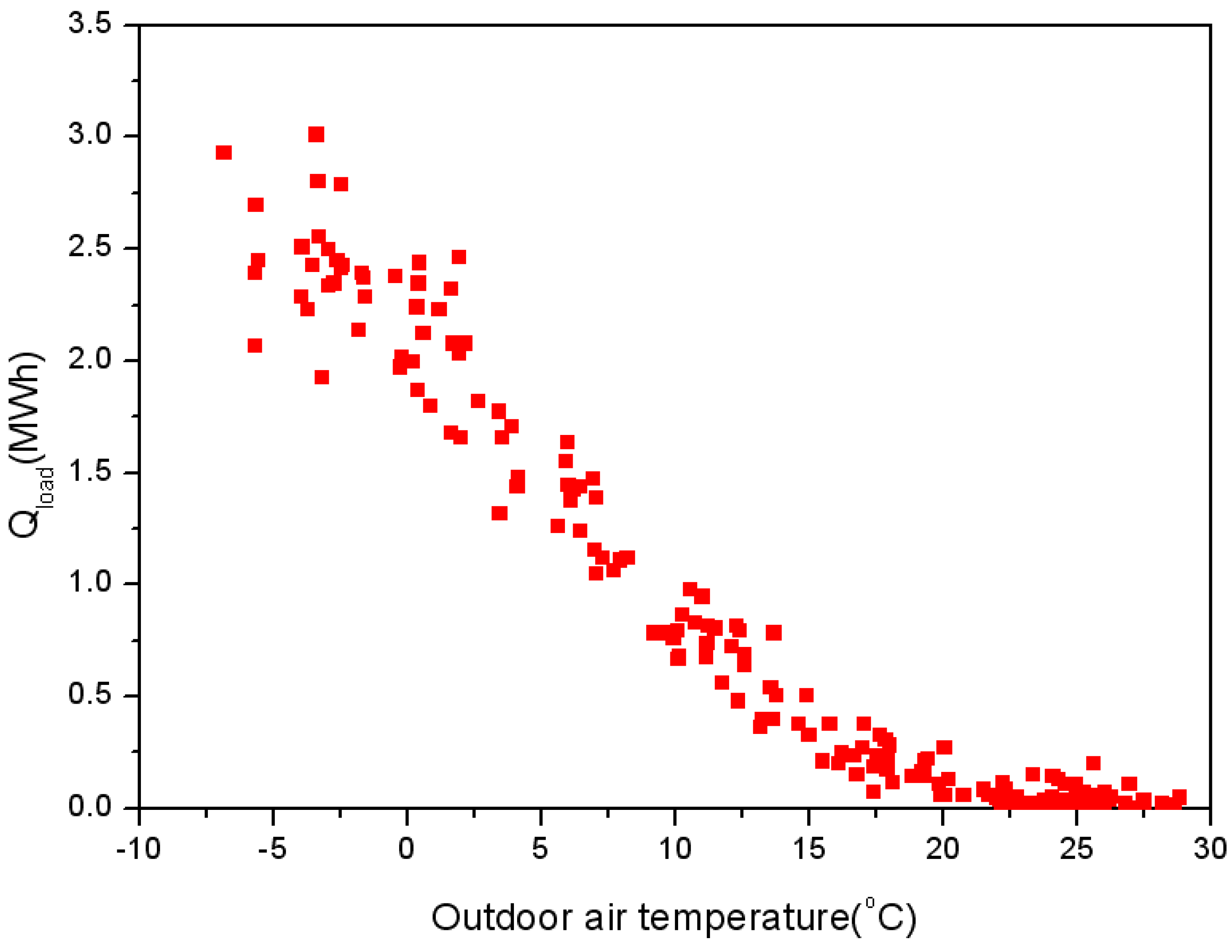
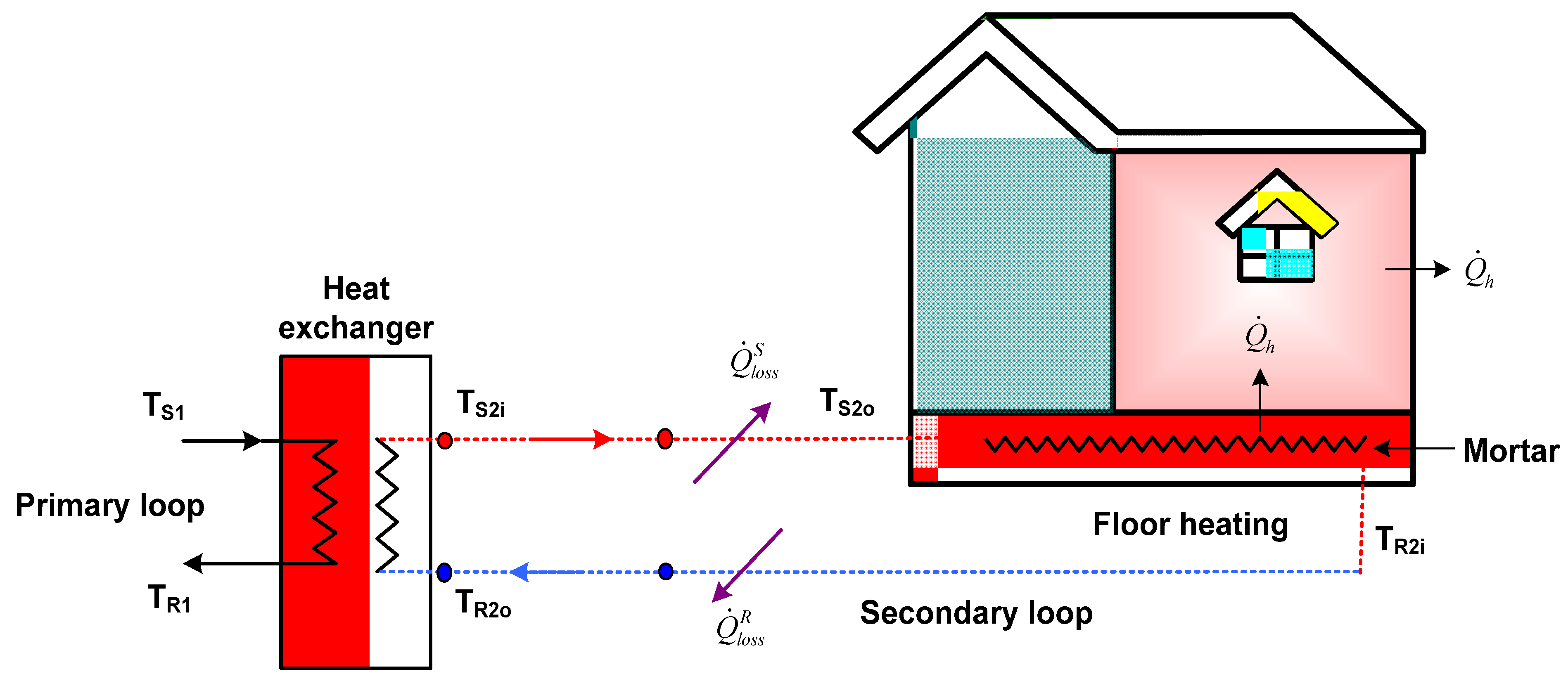
4. Development of Optimal Heat Supply Control Algorithm for Group Energy Secondary Loop
4.1. Heat Exchange Model of Traditional Korean Floor Heating
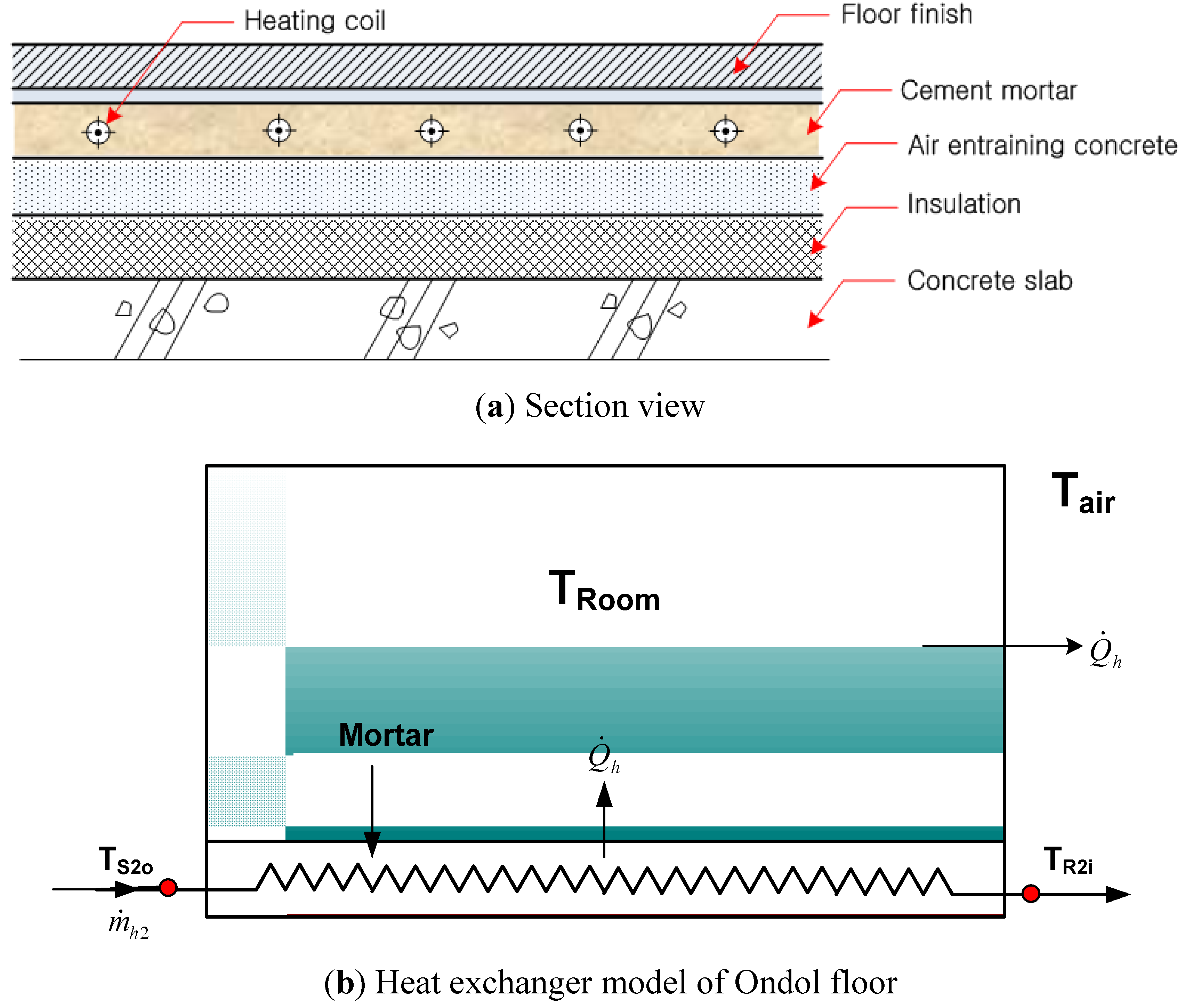
4.2. Heat Loss Rate at the Supply Water Line

4.3. Heat Loss Rate at the Return Water Line

5. Results and Discussion

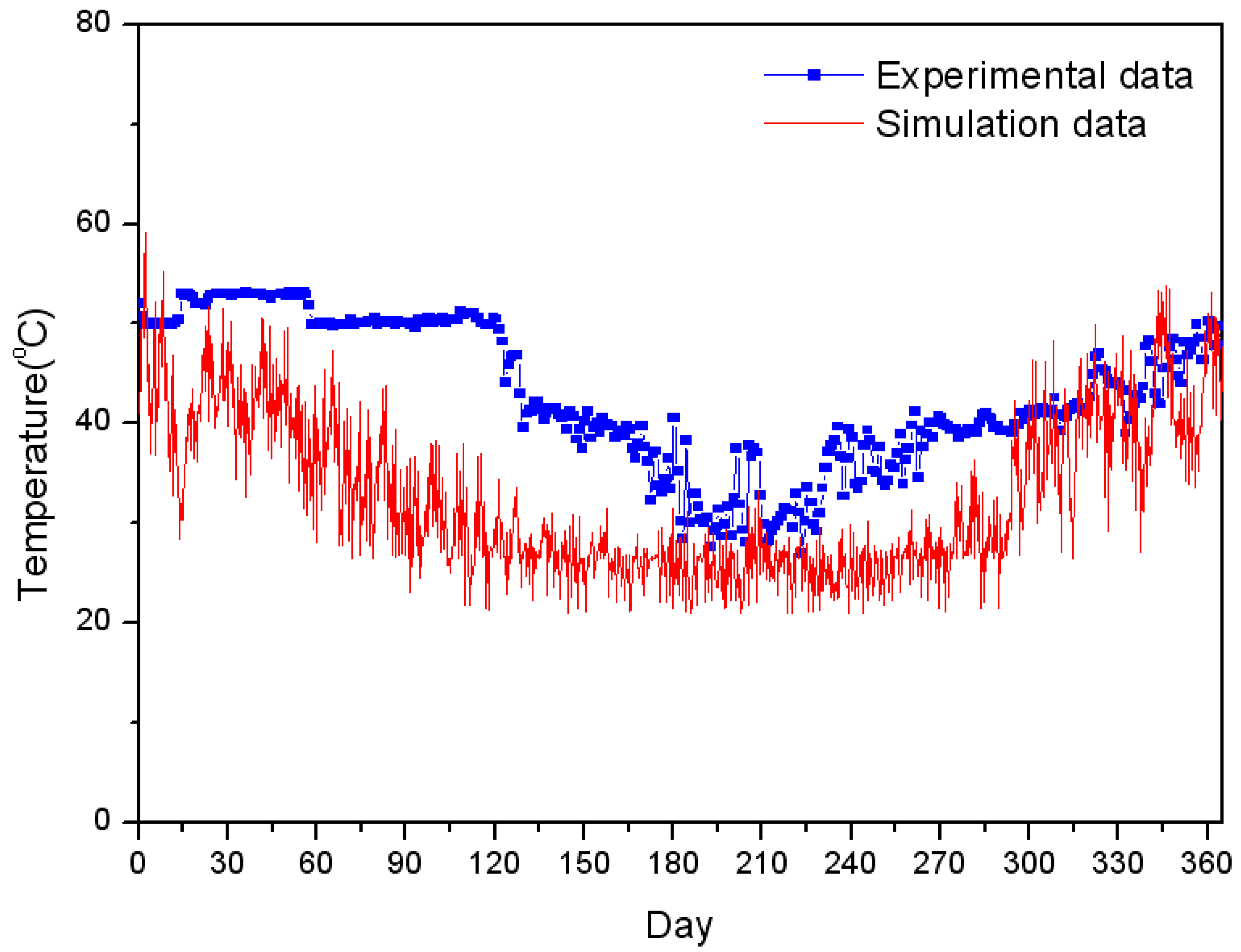
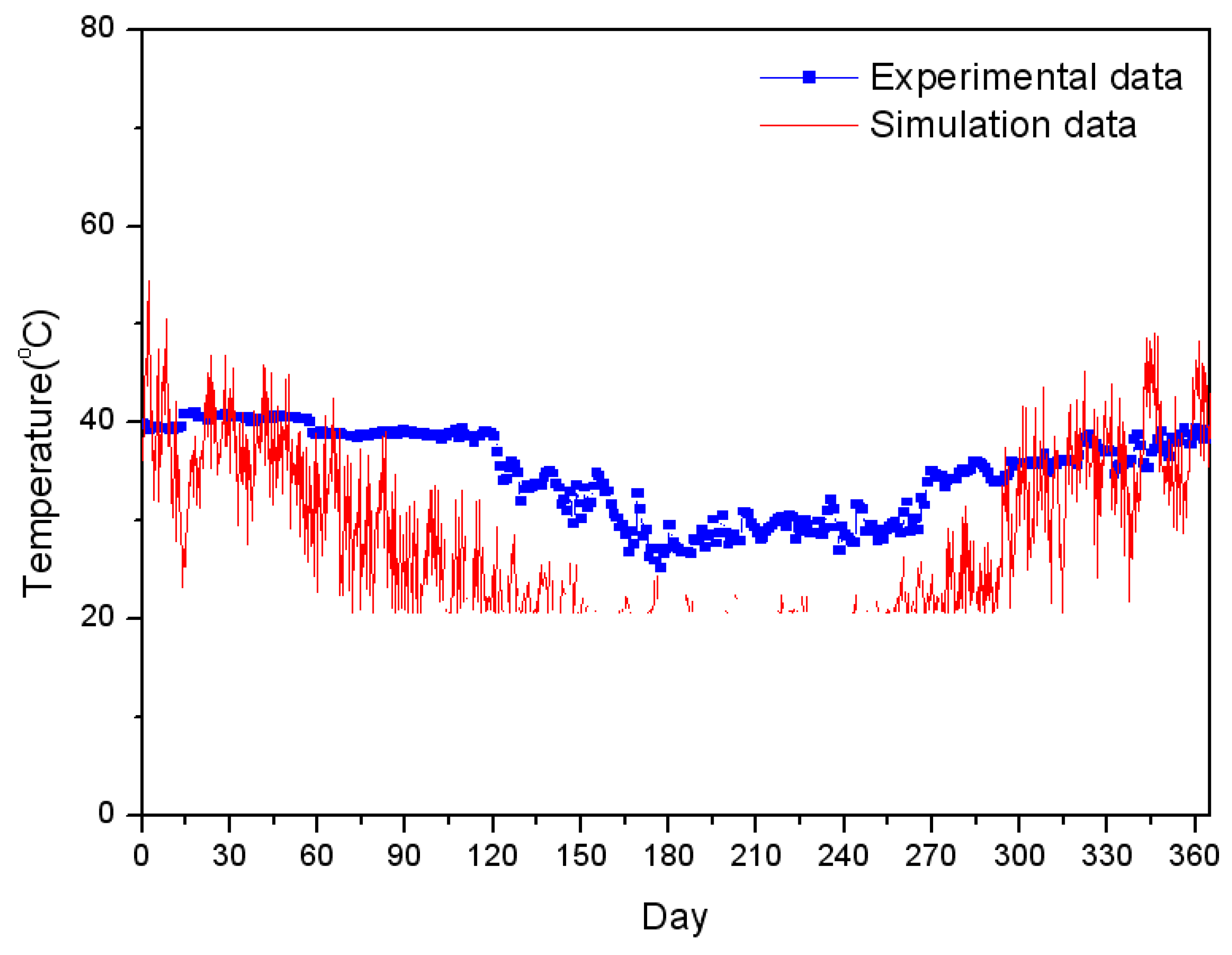
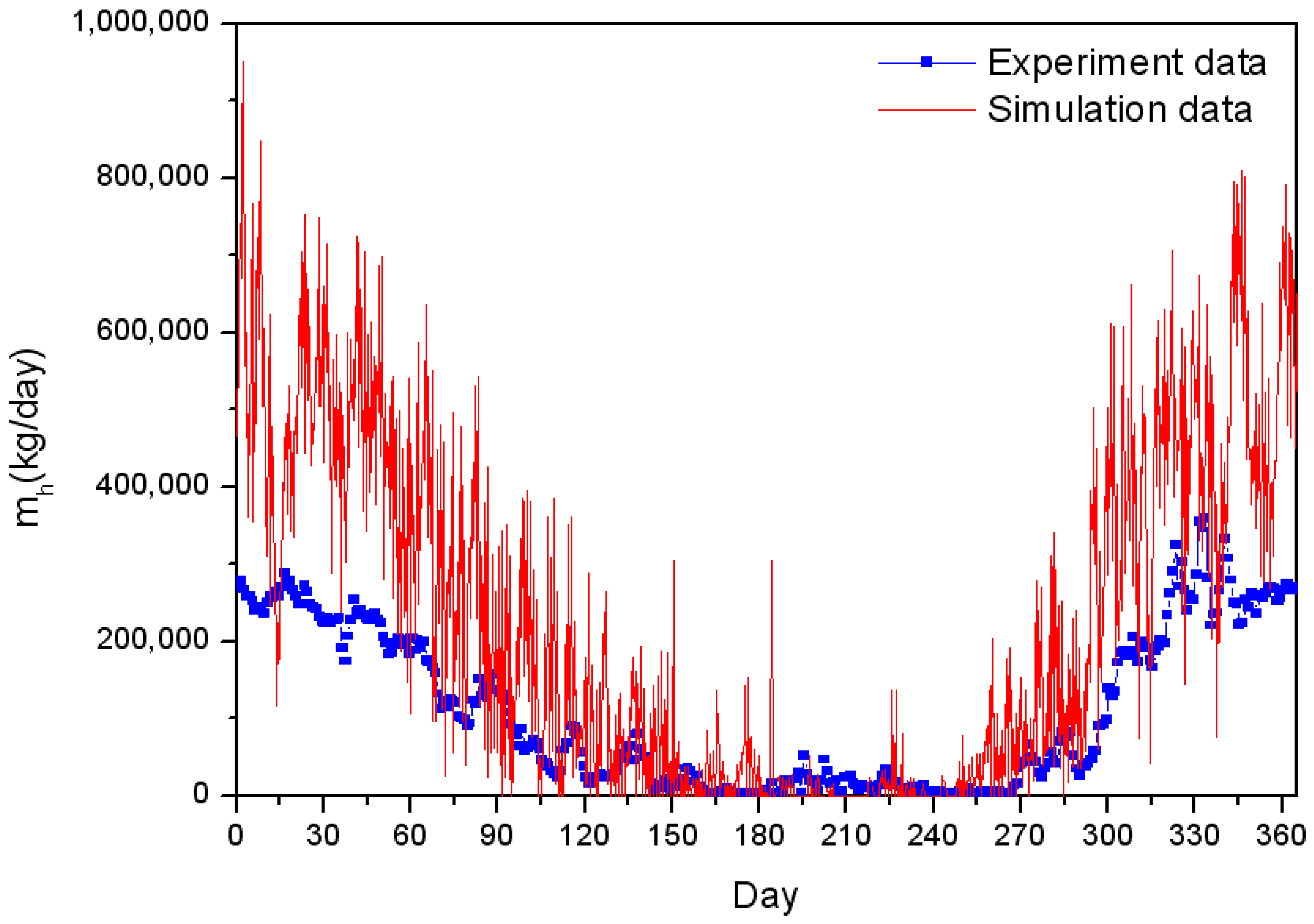
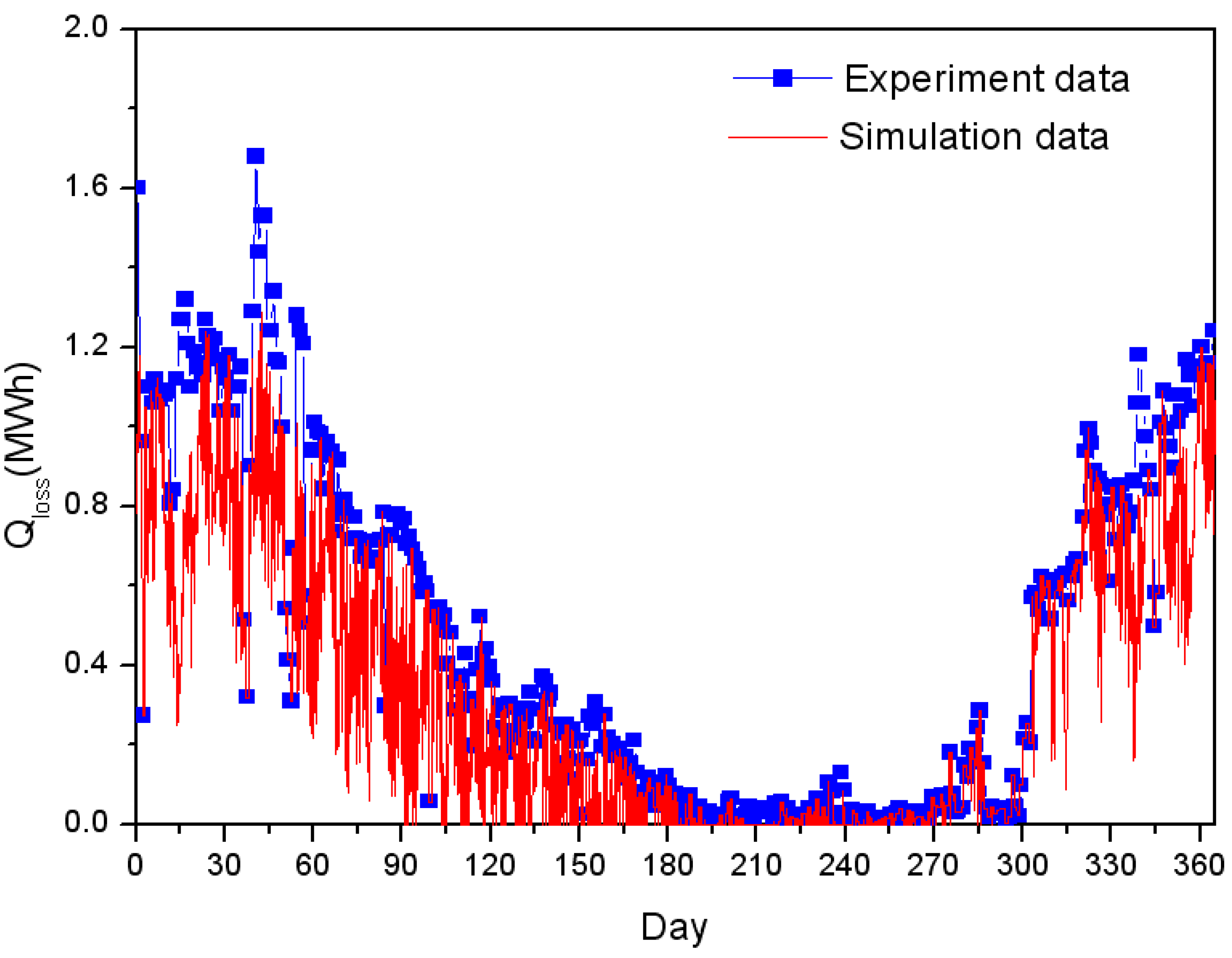
6. Conclusions
- (1)
- This study was based on the apartment building heat consumption data collected in year 2008. Thus, if an accurate database on heat supply and consumption pattern can be obtained, the developed system can accurately predict heat load variations according to outdoor temperature.
- (2)
- Heat load was predicted for group energy apartment buildings. The predictions were compared with experimental data for validation. The results of the heat load prediction method for group energy apartment buildings agreed well with experimental data.
- (3)
- In this study, energy loss was decreased by 10.4% compared to the supply heat by applying the lowest supply water temperature and return water temperature in the optimal heat supply control system.
- (4)
- Heat supply control can be achieved by variable supply mass flow rate control and variation supply water temperature control. To meet consumer heat capacity needs, mass flow rate is varied according to supply water temperature. Low mass flow rate is applied for high supply water temperature, while mass flow rate is increased when the supply water temperature is low.
- (5)
- Primary return water temperature without affecting the indoor temperature. Thus a better utilization of the heat generated from heat generation facility is achievable. The optimal primary side supply water temperature is found when the return water temperature reaches its minimum under the heat control algorithm.
- (6)
- Analysis results of this study can be used to evaluate heat consumption patterns according to outdoor temperature. The analysis results suggest that further research in this area could lead to substantial energy savings in apartment buildings.
References
- Bøhm, B.; Danig, P.O. Monitoring the energy consumption in a district heated apartment building in Copenhagen, with specific interest in the thermodynamic performance. Energy Build. 2004, 36, 229–236. [Google Scholar]
- Stevanovic, V.D.; Prica, S.; Maslovaric, B.; Zivkovic, B.; Nikodijevic, S. Efficient numerical method for district heating system hydraulics. Energy Convers. Manag. 2007, 48, 1536–1543. [Google Scholar] [CrossRef]
- Wu, Y.G.; Rosen, M.A. Assessing and optimizing the economic and environmental impacts of cogeneration/district energy systems using an energy equilibrium model. Appl. Energy 1999, 62, 141–154. [Google Scholar] [CrossRef]
- Dotzauer, E. Experiences in mid-term planning of district heating systems. Energy 2003, 28, 1545–1555. [Google Scholar] [CrossRef]
- Dotzauer, E. Simple model for prediction of loads in district-heating systems. Appl. Energy 2002, 73, 277–284. [Google Scholar] [CrossRef]
- Heller, A.J. Heat-load modelling for large systems. Appl. Energy 2002, 72, 371–387. [Google Scholar] [CrossRef]
- Knutsson, D.; Sahlin, J.; Werner, S.; Ekvall, T.; Ahlgren, E.O. HEATSPOT—A simulation tool for national district heating analyses. Energy 2006, 31, 278–293. [Google Scholar] [CrossRef]
- Shimoda, Y.; Nagota, T.; Isayama, N.; Mizuno, M. Verification of energy efficiency of district heating and cooling system by simulation considering design and operation parameters. Build. Environ. 2006, 43, 569–577. [Google Scholar] [CrossRef]
- Fu, L.; Yi, J.; Yuan, W.; Qin, X. Influence of supply and return water temperatures on the energy consumption of a district cooling system. Appl. Therm. Eng. 2001, 21, 511–521. [Google Scholar] [CrossRef]
- Larsen, H.V.; Palsson, H.; Bøhm, B.; Wigbels, M. A comparison of aggregated models for simulation and operational optimisation of district heating networks. Energy Convers. Manag. 2004, 45, 1119–1139. [Google Scholar] [CrossRef]
- Salsbury, T.; Diamond, R. Performance validation and energy analysis of HVAC system using simulation. Energy Build. 2000, 21, 5–17. [Google Scholar] [CrossRef]
- Bojic, M.; Trifunovic, N.; Gustafsson, S.I. Mixed 0–1 sequential linear programming optimization of heat distribution in a district-heating system. Energy Build. 2000, 32, 309–317. [Google Scholar] [CrossRef]
- Nielsen, H.; Madsen, H. Modelling the heat consumption in district heating systems using a grey-box approach. Energy Build. 2000, 38, 63–71. [Google Scholar] [CrossRef]
- Holmgren, K.; Gebremedhin, A. Modelling a district heating system: Introduction of waste incineration, policy instruments and co-operation with an industry. Energy Policy 2004, 32, 1807–1817. [Google Scholar] [CrossRef]
- Henning, D.; Amiri, S.; Holmgren, K. Modelling and optimisation of electricity, steam and district heating production for a local Swedish utility. Eur. J. Oper. Res. 2006, 175, 1224–1247. [Google Scholar] [CrossRef]
- Gabrielaitiene, I.; Bøhm, B.; Sunden, B. Modelling temperature dynamics of a district heating system in Naestved, Denmark—A case study. Energy Convers. Manag. 2007, 48, 78–86. [Google Scholar] [CrossRef]
- Lianzhong, L.; Zaheeruddin, M. A control strategy for energy optimal operation of a direct district heating system. Int. J. Energy Res. 2004, 28, 597–612. [Google Scholar] [CrossRef]
- Langendries, R. Low return temperature (LRT) in district heating. Energy Build. 1998, 12, 191–200. [Google Scholar] [CrossRef]
- Kim, M.H. Low Thermal Quantity and Pattern of Special Facilities Connected by a District Heat. M.S. Thesis, Hanyang University, Seoul, Korea, February 2007. [Google Scholar]
- Kim, S.K.; Lee, D.H.; Hong, H.K. An energy saving technique using Ondol heating schedule control of housing units in Korea. Indoor Built Environ. 2009, 19, 88–93. [Google Scholar] [CrossRef]
- Lee, C.S.; Choi, Y.D. Analysis of energy consumption of office building by thermal resistance-capacitance method. Korea J. Air-Cond. Ref. Eng. 1997, 9, 1–13. [Google Scholar]
- Yoon, J.H.; Hong, J.K.; Lee, N.H.; Choi, Y.D. Simulation of thermal performance of model hot water panel house in consideration of radiant heat transfer. Korea J. Air-Cond. Ref. Eng. 1993, 5, 295–305. [Google Scholar]
© 2012 by the authors; licensee MDPI, Basel, Switzerland. This article is an open access article distributed under the terms and conditions of the Creative Commons Attribution license (http://creativecommons.org/licenses/by/3.0/).
Share and Cite
Byun, J.-K.; Choi, Y.-D.; Shin, J.-K.; Park, M.-H.; Kwak, D.-K. Study on the Development of an Optimal Heat Supply Control Algorithm for Group Energy Apartment Buildings According to the Variation of Outdoor Air Temperature. Energies 2012, 5, 1686-1704. https://doi.org/10.3390/en5051686
Byun J-K, Choi Y-D, Shin J-K, Park M-H, Kwak D-K. Study on the Development of an Optimal Heat Supply Control Algorithm for Group Energy Apartment Buildings According to the Variation of Outdoor Air Temperature. Energies. 2012; 5(5):1686-1704. https://doi.org/10.3390/en5051686
Chicago/Turabian StyleByun, Jae-Ki, Young-Don Choi, Jong-Keun Shin, Myung-Ho Park, and Dong-Kurl Kwak. 2012. "Study on the Development of an Optimal Heat Supply Control Algorithm for Group Energy Apartment Buildings According to the Variation of Outdoor Air Temperature" Energies 5, no. 5: 1686-1704. https://doi.org/10.3390/en5051686





